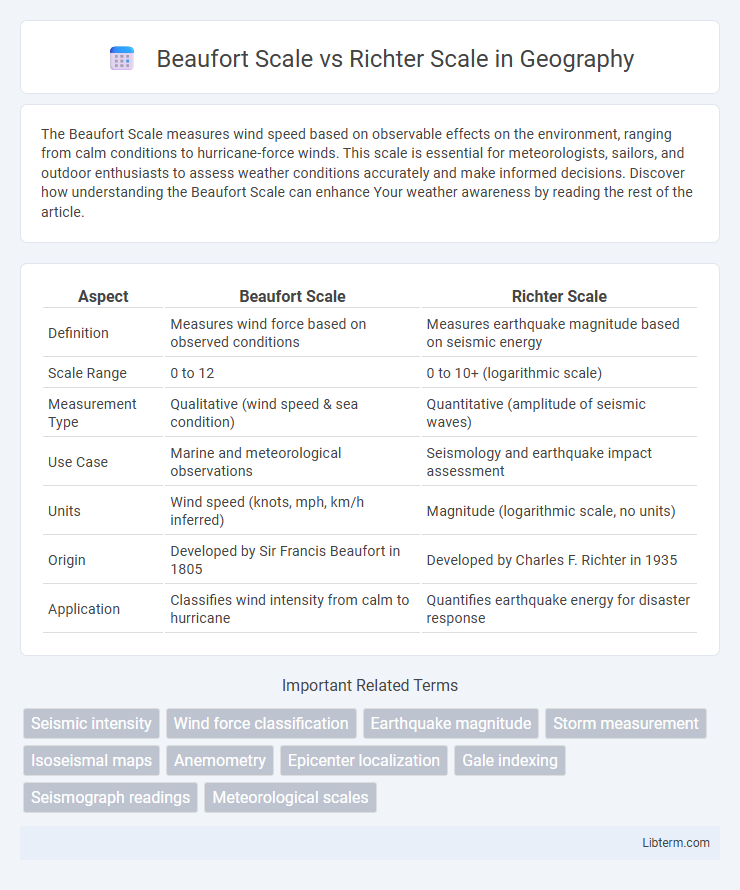The Beaufort Scale measures wind speed based on observable effects on the environment, ranging from calm conditions to hurricane-force winds. This scale is essential for meteorologists, sailors, and outdoor enthusiasts to assess weather conditions accurately and make informed decisions. Discover how understanding the Beaufort Scale can enhance Your weather awareness by reading the rest of the article.
Table of Comparison
| Aspect | Beaufort Scale | Richter Scale |
|---|---|---|
| Definition | Measures wind force based on observed conditions | Measures earthquake magnitude based on seismic energy |
| Scale Range | 0 to 12 | 0 to 10+ (logarithmic scale) |
| Measurement Type | Qualitative (wind speed & sea condition) | Quantitative (amplitude of seismic waves) |
| Use Case | Marine and meteorological observations | Seismology and earthquake impact assessment |
| Units | Wind speed (knots, mph, km/h inferred) | Magnitude (logarithmic scale, no units) |
| Origin | Developed by Sir Francis Beaufort in 1805 | Developed by Charles F. Richter in 1935 |
| Application | Classifies wind intensity from calm to hurricane | Quantifies earthquake energy for disaster response |
Introduction to Measurement Scales
The Beaufort Scale measures wind speed based on observed sea conditions and land effects, ranging from 0 (calm) to 12 (hurricane). The Richter Scale quantifies earthquake magnitude by calculating the seismic energy released, using logarithmic values from minor tremors to major quakes. Both scales standardize natural phenomena recording, facilitating communication and safety measures across meteorology and seismology.
What is the Beaufort Scale?
The Beaufort Scale is a standardized system used to estimate wind speed based on observed sea or land conditions, ranging from 0 (calm) to 12 (hurricane-force winds). It was developed in 1805 by Sir Francis Beaufort and remains essential for maritime navigation and weather forecasting. Unlike the Richter Scale, which measures earthquake magnitude, the Beaufort Scale quantifies wind intensity through visual indicators rather than seismic data.
What is the Richter Scale?
The Richter Scale measures the magnitude of earthquakes by quantifying the seismic energy released, using a logarithmic scale ranging from 0 to 10. Developed in 1935 by Charles F. Richter, it assigns a numerical value based on the amplitude of seismic waves recorded by seismographs. Unlike the Beaufort Scale, which categorizes wind speeds from 0 (calm) to 12 (hurricane-force), the Richter Scale specifically evaluates earthquake intensity and helps assess potential damage and required safety measures.
Historical Backgrounds of Both Scales
The Beaufort Scale, developed in 1805 by Sir Francis Beaufort of the British Royal Navy, was initially designed to estimate wind force based on observed sea conditions, providing a standardized method for sailors to report weather. In contrast, the Richter Scale, introduced in 1935 by Charles F. Richter, revolutionized seismology by quantifying earthquake magnitudes using logarithmic measurements of seismic wave amplitudes recorded by seismographs. Both scales emerged from the need for precise, communication-friendly metrics in their respective fields--meteorology and geology--significantly enhancing safety and scientific understanding.
How the Beaufort and Richter Scales Work
The Beaufort Scale measures wind speed by categorizing conditions from calm air (0) to hurricane-force winds (12) based on observable sea or land effects. The Richter Scale quantifies earthquake magnitude by analyzing the amplitude of seismic waves recorded by seismographs, providing a logarithmic value where each whole number increase represents a tenfold increase in measured amplitude. Both scales offer standardized methods for assessing natural phenomena, facilitating communication and response efforts in meteorology and seismology.
Key Differences Between Beaufort and Richter Scales
The Beaufort Scale measures wind speed using qualitative observations and ranges from 0 to 12, primarily applied in meteorology and marine contexts. The Richter Scale quantifies earthquake magnitude on a logarithmic scale, capturing seismic energy release with no upper limit and is crucial for seismology and earthquake analysis. Key differences include their measurement focus--wind velocity versus earthquake magnitude--and their scale types: descriptive versus numerical logarithmic.
Applications in Weather and Earthquake Assessment
The Beaufort Scale is primarily used for measuring wind speed and assessing weather conditions, particularly in maritime and coastal environments, aiding in navigation and safety decisions. The Richter Scale quantifies earthquake magnitude based on seismic wave amplitude, playing a crucial role in earthquake assessment and disaster response planning. Both scales provide essential data that inform risk management and protective measures in their respective fields.
Limitations of Each Scale
The Beaufort Scale, primarily used to estimate wind force based on visual observations, lacks precise quantitative wind speed measurements, making it less reliable for scientific analysis and extreme weather events. The Richter Scale, designed to measure earthquake magnitude through seismic wave amplitude, often underestimates energy release for very large earthquakes and is less accurate for distant or deep seismic events. Both scales have limitations in their scope and accuracy, necessitating complementary measurement methods for comprehensive environmental monitoring.
Modern Alternatives and Enhancements
Modern alternatives to the Beaufort Scale include digital anemometers and satellite-based wind measurement systems, providing precise real-time data on wind speed and direction beyond the subjective descriptions of the original scale. Enhancements to the Richter Scale feature moment magnitude scales (Mw) that offer more accurate assessments of earthquake size across a broader range of magnitudes and distances, improving predictive capabilities. Both scales have evolved through integration with advanced sensor technologies and data analysis software, enabling better disaster preparedness and response.
Conclusion: Choosing the Right Scale for Measurement
The Beaufort Scale effectively measures wind intensity based on observable effects, making it ideal for meteorological and nautical applications. The Richter Scale quantifies earthquake magnitude through seismic wave amplitude, providing precise data crucial for geophysical studies and disaster response. Selecting the appropriate scale depends on whether the focus is on wind force assessment or earthquake energy measurement, ensuring accurate and relevant data collection.
Beaufort Scale Infographic

 libterm.com
libterm.com